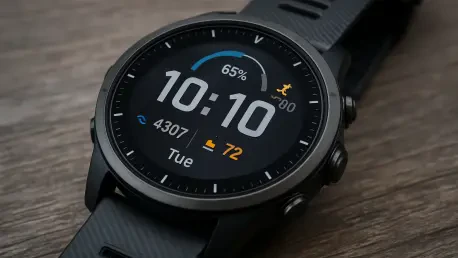In the ever-evolving landscape of fitness and lifestyle wearables, Garmin has solidified its reputation as a go-to brand for devices that cater to a wide spectrum of users, from casual exercisers to dedicated athletes pushing their limits. Two of the company’s standout offerings, the Venu 4 and Vivoactive 6, have captured significant attention among tech-savvy fitness enthusiasts looking for the perfect balance of style, functionality, and value. With both smartwatches boasting Garmin’s hallmark focus on health tracking and performance metrics, the question arises: which device truly delivers the best experience for its intended audience? This in-depth comparison aims to unpack the nuances between these two models, guiding potential buyers toward a choice that aligns with their unique needs and preferences.
The Venu 4 positions itself as a premium option, packed with advanced features and a refined design, while the Vivoactive 6 targets those seeking a more budget-friendly yet reliable companion for everyday activities. By delving into critical aspects such as design aesthetics, technical capabilities, battery endurance, fitness tracking depth, smart functionalities, and overall cost-effectiveness, this analysis seeks to provide clarity on how each watch performs in real-world scenarios. Whether upgrading an existing wearable or stepping into Garmin’s ecosystem for the first time, understanding the strengths and trade-offs of each device is essential for making an informed decision that complements one’s lifestyle and fitness goals.
Design Aesthetics: Balancing Style and Comfort
When evaluating the design of the Venu 4 and Vivoactive 6, it’s evident that both smartwatches adhere to Garmin’s signature aesthetic with vibrant round AMOLED displays and intuitive two-button navigation systems. However, distinct differences emerge in their build quality and sizing options. The Venu 4 offers a choice between 41mm and 45mm cases, catering to varied wrist sizes and personal style preferences, and incorporates a stainless steel bezel paired with a fiber-reinforced polymer case for a sophisticated, durable finish. In contrast, the Vivoactive 6 comes in a single 42mm size, utilizing an anodized aluminum bezel that prioritizes affordability while maintaining a sleek appearance. Weight also plays a significant role in wearability, with the Venu 4 ranging from 46 to 56 grams depending on the size, giving it a more substantial feel, whereas the Vivoactive 6’s lighter 36-gram build enhances comfort for extended wear, particularly during sleep tracking or all-day use.
Beyond materials, subtle design elements further differentiate the two. The Venu 4 sticks to understated color palettes such as Slate and Silver, appealing to those who prefer a professional or minimalist look suitable for both workouts and office settings. Meanwhile, the Vivoactive 6 introduces more vibrant options like Jasper Green and Pink Dawn, adding a playful touch for users wanting to express individuality through their wearable. Practical additions, such as the Venu 4’s built-in LED flashlight, provide an edge for low-light activities like early morning runs, a feature absent in the Vivoactive 6. Ultimately, the Venu 4 leans toward a premium, versatile design that transitions seamlessly across contexts, while the Vivoactive 6 focuses on lightweight simplicity, ideal for users prioritizing ease over luxury.
Technical Capabilities: Advanced Features vs. Core Essentials
Exploring the technical specifications reveals a clear hierarchy between the Venu 4 and Vivoactive 6, with the former offering a broader array of cutting-edge sensors and connectivity options. Both devices cover fundamental health metrics through sensors like optical heart rate monitors, accelerometers, and Pulse Ox for blood oxygen saturation, ensuring a solid baseline for fitness tracking. However, the Venu 4 steps ahead with Garmin’s Elevate V5 heart rate technology for potentially more precise readings, alongside exclusive features such as ECG for heart rhythm analysis, skin temperature monitoring, and a barometric altimeter for elevation data—tools not found in the Vivoactive 6. Additionally, the Venu 4’s multi-band GNSS support enhances GPS accuracy in challenging environments like dense urban areas or thick forests, surpassing the standard GNSS capabilities of the Vivoactive 6, which may struggle under similar conditions.
Smart functionalities further highlight the disparity in their tech offerings. The Venu 4 integrates a built-in speaker and microphone, enabling Bluetooth phone calls, voice assistant interactions, and audio workout prompts, positioning it as a true hybrid device for both fitness and daily convenience. In contrast, the Vivoactive 6 limits its smart features to essentials like notifications, music storage, and Garmin Pay for contactless payments, lacking the interactive depth of its pricier counterpart. For users seeking a wearable that extends beyond basic tracking to serve as a seamless extension of their smartphone, the Venu 4 stands out. However, for those content with straightforward functionality without the bells and whistles, the Vivoactive 6 remains a competent choice that avoids overwhelming complexity.
Battery Performance: Endurance for Diverse Needs
Battery life often serves as a deciding factor for smartwatch users, and the performance of the Venu 4 and Vivoactive 6 varies depending on usage patterns and enabled features. In standard smartwatch mode without the always-on display, the Venu 4 in its 45mm variant lasts up to 12 days, narrowly outpacing the Vivoactive 6’s 11 days, demonstrating comparable efficiency for basic operations. However, when the always-on display is activated, the Vivoactive 6 gains an advantage, stretching to 5 days compared to the Venu 4’s 3 to 4 days across its size options, likely due to its less demanding hardware. This makes the Vivoactive 6 a stronger contender for users who value screen visibility without frequent charging.
In more intensive scenarios like GPS tracking, the results present a mixed picture. The Vivoactive 6 delivers 21 hours in GPS-only mode, slightly better than the Venu 4’s 15 to 20 hours depending on size, catering well to users engaging in long outdoor activities without advanced positioning needs. However, the Venu 4’s exclusive multi-band GNSS mode, while reducing battery life to 17 hours, offers superior location accuracy—a trade-off that benefits athletes navigating complex terrains. When music playback is factored into GPS usage, endurance drops further, with the Venu 4 lasting 9 hours in multi-band mode compared to the Vivoactive 6’s 8 hours. For casual users prioritizing efficiency over precision, the Vivoactive 6 might suffice, but those requiring enhanced tracking capabilities will find the Venu 4’s flexibility more aligned with demanding routines.
Fitness and Health Monitoring: Depth for Every Level
Health and wellness tracking forms the core of both the Venu 4 and Vivoactive 6, yet their approaches cater to different user expectations. Both smartwatches monitor essential metrics such as heart rate, stress levels, respiration rate, and sleep patterns, providing a reliable foundation for daily wellness insights. The Venu 4, however, elevates this experience with advanced features like skin temperature tracking to assess heat responses, a Jet Lag Adviser for travelers, and automatic sleep alignment tools to optimize rest cycles. These additions offer a more comprehensive view of one’s physical state, appealing to users who want detailed data to inform lifestyle adjustments or recovery strategies. The Vivoactive 6, while effective for basic monitoring, skips these sophisticated tools, focusing instead on delivering straightforward, easy-to-understand health information.
Turning to fitness capabilities, the Venu 4 emerges as a powerhouse for serious athletes with structured coaching plans through Garmin Fitness Coach, detailed running metrics like vertical oscillation and stride length (with compatible accessories), and navigation tools for outdoor pursuits. Cyclists and multisport enthusiasts also benefit from power data integration and compatibility with accessories like Varia headlights. In contrast, the Vivoactive 6 sticks to fundamental activity tracking, offering limited recovery data and basic heart rate broadcasting without the depth of analysis or guided workouts. While it supports speed and cadence sensors for cycling, it lacks the advanced metrics and planning features of the Venu 4. For casual exercisers, the Vivoactive 6 provides adequate support, but dedicated fitness buffs will gravitate toward the Venu 4’s robust toolkit tailored for performance optimization.
Smart Functionalities: Enhancing Daily Convenience
Beyond their fitness focus, these smartwatches offer varying levels of everyday utility through smart features designed to streamline routines. The Venu 4 excels in this arena with hands-free conveniences like Bluetooth phone calls, voice assistant integration, and on-device voice commands, allowing users to manage tasks or communicate without needing to interact directly with the device. Additional perks, such as Color Shift for improved nighttime readability and live event sharing, enhance its practicality for busy lifestyles. These capabilities position the Venu 4 as a versatile companion that bridges the gap between a fitness tracker and a full-fledged smart device, catering to tech-savvy individuals who value seamless connectivity.
The Vivoactive 6, while equipped with core smartwatch functions, takes a more restrained approach. It supports notifications, music storage for offline playlists, and Garmin Pay for contactless transactions, meeting the basic needs of users who want minimal smartphone dependency during workouts or errands. However, it misses out on the interactive and voice-based features that make the Venu 4 stand out, limiting its appeal for those seeking a more dynamic experience. For individuals whose primary focus is fitness tracking with occasional smartwatch perks, the Vivoactive 6 suffices, but users desiring a wearable that integrates deeply into daily activities will find the Venu 4’s broader feature set far more compelling and convenient.
Price and Value Analysis: Matching Cost to Needs
The financial aspect plays a pivotal role in distinguishing the Venu 4 from the Vivoactive 6, with a significant price gap reflecting their differing target markets. Priced at $550, the Venu 4 commands a premium that corresponds to its high-end build, advanced sensors, multi-band GNSS accuracy, comprehensive fitness tools, and extensive smart features. This cost makes it a worthwhile investment for dedicated athletes, runners, cyclists, or outdoor adventurers who will fully utilize its capabilities for training analysis and lifestyle integration. However, the heavier design and slightly reduced battery life in certain modes, combined with the steep price tag, might deter casual users who don’t require such extensive functionality.
At $300, the Vivoactive 6 offers a more accessible entry point into Garmin’s ecosystem, delivering excellent value for those seeking a lightweight, comfortable device with reliable core tracking, a vibrant display, and decent battery endurance. It meets the demands of everyday fitness monitoring without overwhelming users with features they might not use, though it falls short for those needing in-depth metrics, structured coaching, or advanced navigation support. The decision hinges on individual priorities and budget constraints—whether to invest in the Venu 4 for depth and versatility or opt for the Vivoactive 6 for simplicity and affordability. Both devices uphold Garmin’s commitment to quality, but they cater to distinct ends of the fitness and lifestyle spectrum.
Final Verdict: Choosing the Right Fit
Reflecting on the comparison, the Venu 4 stands out as the more robust and feature-packed option, excelling in advanced health monitoring, precise GPS tracking with multi-band support, detailed fitness coaching, and smart conveniences that extend its utility beyond workouts. It proves to be the ideal choice for serious athletes or tech enthusiasts who value versatility and are willing to pay a premium for cutting-edge capabilities. On the other hand, the Vivoactive 6 carves a niche as a practical, budget-friendly alternative, delivering essential tracking and a comfortable design that suits casual users without the complexity or cost of higher-end models.
Looking ahead, potential buyers should weigh their specific goals against the strengths of each device. For those committed to elevating their fitness journey with detailed insights and structured guidance, investing in the Venu 4 will likely yield long-term satisfaction. Conversely, individuals seeking a straightforward, cost-effective tracker for daily activity monitoring might find the Vivoactive 6 to be a perfect match. As technology continues to advance, considering how each smartwatch aligns with personal habits and future aspirations—be it deeper performance analysis or simply staying active—will ensure a choice that remains relevant and supportive over time.









